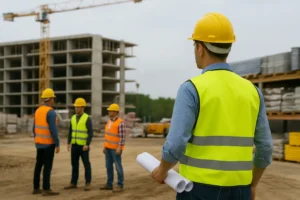Modular construction has quickly moved from niche to mainstream; especially in multifamily, healthcare, education, and hospitality. Owners love the speed. Architects like the design control. And contractors? Well, that depends on who’s estimating it.
Because while modular can save time and reduce labor exposure, it also introduces cost variables that traditional bid models don’t always capture.
If you’re bidding, budgeting, or managing modular projects, here’s what to weigh, the real pros, the hidden cons, and what it means for your estimates.
What Modular Construction Really Means
At its core, modular construction shifts a large portion of the work from field to factory. Instead of building everything onsite, components or “modules” are fabricated offsite, transported, and assembled onsite, almost like large-scale Lego blocks.
Two main types dominate the industry:
- Volumetric Modular: Fully enclosed modules (like hotel rooms or apartments) built offsite and stacked onsite.
- Panelized Systems: Wall, floor, and roof panels pre-manufactured for rapid site assembly.
From an estimator’s perspective, the difference is huge, volumetric is about assembly pricing, while panelized is still field-built work with prefab elements.
The Pros: Why Modular Keeps Growing
1. Faster Project Delivery
Factory production can run in parallel with site prep and foundation work, cutting overall project schedules by 20–50%. For developers and owners, faster delivery means earlier occupancy and revenue, a major ROI driver.
Estimator Note: Shorter duration reduces General Conditions and financing costs but increases the need for tight schedule coordination and transport logistics.
2. Predictable Labor Costs
Labor shortages are one of the biggest risks in construction. Modular mitigates that by shifting work to a controlled environment with predictable labor output.
Estimator Note:
- Offsite labor costs are usually lower (fewer delays, consistent shifts).
- Field labor reduces drastically, but you’ll still need skilled crews for setting, welding, sealing, and MEP tie-ins.
3. Improved Quality Control
Factory-built modules are assembled under consistent conditions with standardized QA/QC processes. That means fewer rework hours and inspection delays onsite.
Estimator Note: Reduced rework improves cost reliability, but don’t assume factory perfection. Add contingency for site-fit adjustments and transport damage.
4. Sustainability and Waste Reduction
Controlled fabrication leads to less material waste, often up to 90% less compared to traditional builds. Plus, modular systems can easily integrate with green certifications (LEED, WELL, etc.).
The Cons: Where Estimators Get Burned

1. High Upfront Design & Coordination Costs
Modular demands early design finalization; you can’t “figure it out in the field.” Design changes after fabrication are expensive and disruptive.
Estimator Note: Your preconstruction phase must include full BIM coordination, precise shop drawings, and exact trade integration before module release.
2. Transportation and Crane Costs
Modules are large, heavy, and often oversize requiring special hauling permits, escorts, and heavy-lift cranes onsite.
Estimator Note: These costs can rival field labor savings if not carefully planned.
- Long-distance hauling can reach $10–$20 per mile per module.
- Cranes for multi-story stacking can run $10K–$30K per day.
3. Tolerances and Site Fit Issues
Modules aren’t perfect cubes. A ¼-inch tolerance error in a single unit becomes a multi-inch deviation across a building. Site leveling, shimming, welding, and sealing costs add up.
Estimator Note: Always include field alignment, sealing, and waterproofing allowances; typically 2–4% of modular contract value.
4. Financing and Procurement Complexity
Because so much cost occurs before the first module ships, cash flow looks inverted. Owners often must fund up to 60–70% of module fabrication before delivery.
Estimator Note: Your cash flow projection must reflect early pay requests to modular vendors and delayed mobilization of field labor.
5. Limited Local Trade Flexibility
When modular units arrive nearly finished, local trades (especially electrical and plumbing) may have little room for adjustments, but still get blamed for delays.
Estimator Note: Bid scopes must clearly define who finishes what. MEP tie-ins, testing, firestopping, and sealing must be allocated precisely to avoid overlap and change orders.
When Modular Makes the Most Sense
✅ Projects with High Repetition: Hotels, dorms, multifamily, and medical units, repetitive room types benefit the most.
✅ Tight Urban or Weather-Limited Sites: Modular reduces onsite congestion and avoids weather delays.
✅ Labor-Scarce Regions: Shifting production to a manufacturing hub can solve skilled trade shortages in remote markets.
✅ Aggressive Schedules or Public Deadlines: Government, military, and school projects often use modular to meet funding-year completion mandates.
Estimating Checklist for Modular Projects
Before submitting your next modular bid, make sure you’ve accounted for:
- Design finalization and coordination costs (BIM, pre-release meetings)
- Transportation, permits, and staging
- Crane and rigging
- Module sealing, welding, and firestopping
- Tolerances, patching, and trim alignment
- Site-built work (podium, corridors, MEP tie-ins)
- Escalation allowances for factory material volatility
Final Thought
Modular construction isn’t automatically “cheaper.” It’s faster, cleaner, and more predictable, but only when your estimating process reflects the real costs of coordination, transport, and field integration.
The best estimators treat modular like what it really is: a hybrid of manufacturing and construction. Get that balance right, and you’ll not only bid smarter, you’ll help your team deliver modular projects that actually hit the promised savings.
FAQS-Modular building
Modular construction is a process where building modules are manufactured in a factory and then transported to the site for assembly. Unlike traditional construction, which happens entirely onsite, modular methods shift most work offsite—making projects faster, cleaner, and less labor-intensive. However, estimators must account for transport, crane, and coordination costs that don’t exist in conventional builds.
The two main types are volumetric modular and panelized systems.
Volumetric modular uses fully enclosed 3D units (like apartment rooms or hotel suites).
Panelized systems use prefabricated wall, floor, and roof panels assembled onsite.
Each type impacts estimating differently—volumetric focuses on module assembly, while panelized systems require more field labor.
Because modular construction allows offsite fabrication to run at the same time as site and foundation work, total project time can be reduced by 20–50%. This overlap shortens schedules, lowers financing and general condition costs, and lets owners start generating revenue sooner.
Hidden costs often include:
High upfront design and BIM coordination expenses
Transportation, permits, and crane rental fees
Site fit and tolerance adjustments
Complex cash flow due to early vendor payments
Estimators need to include these variables early to avoid costly surprises later.
Modular construction is ideal for projects with repetitive layouts—such as hotels, dormitories, multifamily housing, and healthcare facilities. It’s also valuable for sites with limited access, harsh weather conditions, or labor shortages. These scenarios maximize modular’s speed and predictability advantages.
Estimators should view modular as a hybrid between manufacturing and construction. That means pricing for factory fabrication, transport logistics, and site integration. Include detailed coordination costs, sealing and welding allowances, and cash flow planning for early fabrication payments.





